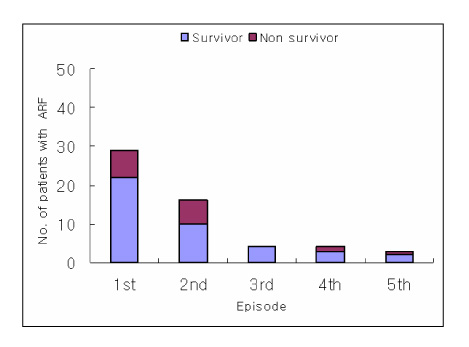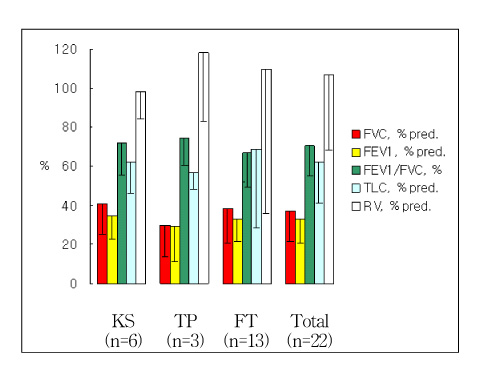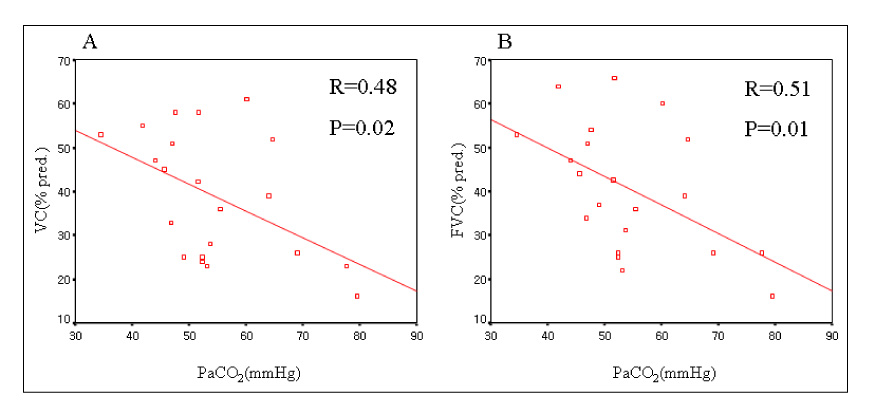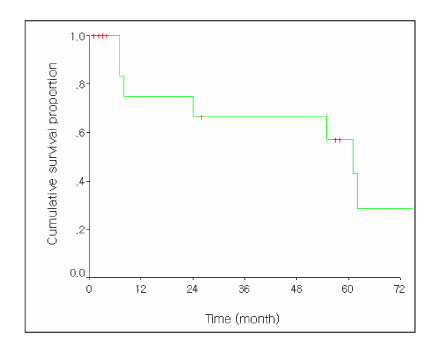Tuberc Respir Dis.
2006 Sep;61(3):265-272. 10.4046/trd.2006.61.3.265.
Long-term Prognosis and Physiologic Status of Patients Requiring Ventilatory Support Secondary to Chest wall Disorders
- Affiliations
-
- 1Department of Internal Medicine, School of Medicine, Kyungpook National University, Daegu, Korea. kimch@knu.ac.kr
- KMID: 1970266
- DOI: http://doi.org/10.4046/trd.2006.61.3.265
Abstract
-
BACKGROUND: Chest wall deformities such as kyphoscoliosis, thoracoplasty, and fibrothorax cause ventilatory insufficiency that can lead to chronic respiratory failure, with recurrent fatal acute respiratory failure(ARF). This study evaluated the frequency and outcome of ARF, the physiologic status, and the long-term prognosis of these patients.
METHODS
Twenty-nine patients with chest wall disorders, who experienced the first requirement of ventilatory support from ARF were examined. The mortality and recurrence rate of ARF, the pulmonary functions with arterial blood gas analysis, the efficacy of home oxygen therapy, and the long-term survival rate were investigated.
RESULTS
1) The mortality of the first ARF was 24.1%. ARF recurred more than once in 72.7% of the remaining 22 patients, and overall rate of successful weaning was 73.2%. 2) Twenty-two patients who recovered from the first ARF showed a restrictive ventilatory impairment with a mean FVC and TLC of 37.2% and 62.4 % of predicted value, respectively, and a mean PaCO2 of 57mmHg. Among the parameters of pulmonaty functions. the FVC(p=0.01) and VC(p=0.02) showed a significant correlation with the PaCO2 level. 3) There were no significant differences between the patients treated with conservative medical treatment only and those with additional home oxygen therapy due to significant hypoxemia in the patients with recurrent ARF and the mortality. 4) The 1, 3, 5-year survival rates were 75%, 66%, and 57%, respectively, in the 20 patients who had recovered from the first ARF, excluding the two patients managed by non-invasive nocturnal ventilatory support.
CONCLUSION
These results suggest that active ventilatory support should be provided to patients with ARF and chest wall disorders. However, considering recurrent ARF and weak effect of home oxygen therapy, non-invasive domiciliary ventilation is recommended in those patients with these conditions to achieve a better long-term prognosis.
MeSH Terms
Figure
Reference
-
1. Bergofsky EH. Respiratory failure in disorders of the thoracic cage. Am Rev Respir Dis. 1979. 119:643–669.2. Shneerson JM, Simonds AK. Noninvasive ventilation for chest wall and neuromuscular disorders. Eur Respir J. 2002. 20:480–487.3. Goldstein RS, McCullough C, Contreras MA. Approaches to rehabilitation of patients with ventilatory insufficiency. Eur Respir J Suppl. 1989. 7:655S–659S.4. Todisco T, Baglioni S, Eslami A, Scoscia E, Todisco C, Bruni L, et al. Treatment of acute exacerbations of chronic respiratory failure: integrated use of negative pressure ventilation and noninvasive positive pressure ventilation. Chest. 2004. 125:2217–2223.5. Shneerson JM. Respiratory failure in tuberculosis: a modern perspective. Clin Med. 2004. 4:72–76.6. Leger P, Bedicam JM, Cornette A, Reybet-Degat O, Langevin B, Polu JM, et al. Nasal intermittent positive pressure ventilation: long-term follow-up in patients with severe chronic respiratory insufficiency. Chest. 1994. 105:100–105.7. Buyse B, Meersseman W, Demedts M. Treatment of chronic respiratory failure in kyphoscoliosis: oxygen or ventilation? Eur Respir J. 2003. 22:525–528.8. Zielinski J. Indications for long-term oxygen therapy: a reappraisal. Monaldi Arch Chest Dis. 1999. 54:178–182.9. Kim WS, Kim KY, Han YC, Suk SI. Ventilatory lung functions in scoliosis. Tuberc Respir Dis. 1984. 31:183–189.10. Bredin CP. Pulmonary function in long-term survivors of thoracoplasty. Chest. 1989. 95:18–20.11. Bolliger CT, de Kock MA. Influence of a fibrothorax on the flow/volume curve. Respiration. 1988. 54:197–200.12. Hukins CA, Hillman DR. Daytime predictors of sleep hypoventilation in Duchenne muscular dystrophy. Am J Respir Crit Care Med. 2000. 161:166–170.13. Miyamoto K, Aida A, Nishimura M, Aiba M, Kira S, Kawakami Y. Gender effect on prognosis of patients receiving long-term home oxygen therapy: the Respiratory Failure Research Group in Japan. Am J Respir Crit Care Med. 1995. 152:972–976.14. Chailleux E, Fauroux B, Binet F, Dautzenberg B, Polu JM. Predictors of survival in patients receiving domiciliary oxygen therapy or mechanical ventilation: a 10-year analysis of ANTADIR Observatory. Chest. 1996. 109:741–749.15. Zielinski J, Sliwinski P, Tobiasz M, Gorecka D, Zielinski J. Long-term oxygen therapy in Poland. Monaldi Arch Chest Dis. 1993. 48:479–480.16. Strom K, Boe J. A national register for long-term oxygen therapy in chronic hypoxia: preliminary results. Eur Respir J. 1988. 1:952–958.17. Huh JW, Lee JY, Hong SB, Oh YM, Shim TS, Lim CM, et al. Long-term oxygen therapy in patients with chronic respiratory failure in one university hospital. Tuberc Respir Dis. 2005. 58:160–166.18. Gorecka D, Gorzelak K, Sliwinski P, Tobiasz M, Zielinski J. Effect of long-term oxygen therapy on survival in patients with chronic obstructive pulmonary disease with moderate hypoxaemia. Thorax. 1997. 52:674–679.19. Crigner GJ. Effects of long-term oxygen therapy on mortality and morbidity. Respir Care. 2000. 45:105–118.20. Haidl P, Clement C, Wiese C, Dellweg D, Kohler D. Long-term oxygen therapy stops the natural decline of endurance in COPD patients with reversible hypercapnia. Respiration. 2004. 71:342–347.21. Zielinski J. Long-term oxygen therapy in conditions other than chronic obstructive pulmonary disease. Respir Care. 2000. 45:172–176.22. Strom K, Pehrsson K, Boe J, Nachemson A. Survival of patients with severe thoracic spine deformities receiving domiciliary oxygen therapy. Chest. 1992. 102:164–168.23. Goldstein RS. Hypoventilation: neuromuscular and chest wall disorders. Clin Chest Med. 1992. 13:507–521.
- Full Text Links
- Actions
-
Cited
- CITED
-
- Close
- Share
- Similar articles
-
- Improvement of Ventilatory Status by HFJV in the Patient with Hypoxemia Refractory to Conventional Mechanical Ventilation
- Clinical Implications of Routine Monitoring of Pulmonary Function and Ventilation in Patients with Duchenne Muscular Dystrophy
- Sonographic Findings of Variable Chest Wall Disorders
- Oxygen and Ventilatory Therapy and Lung Transplantation of the Chronic Obstructive Pulmonary Disease (COPD)
- The Clinical Feature and Pressure Threshold in a Chest Wall Syndrome





